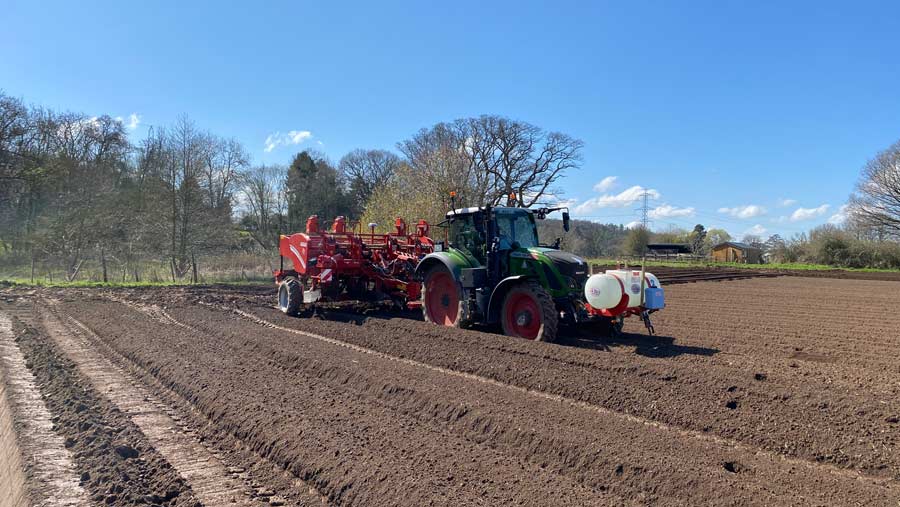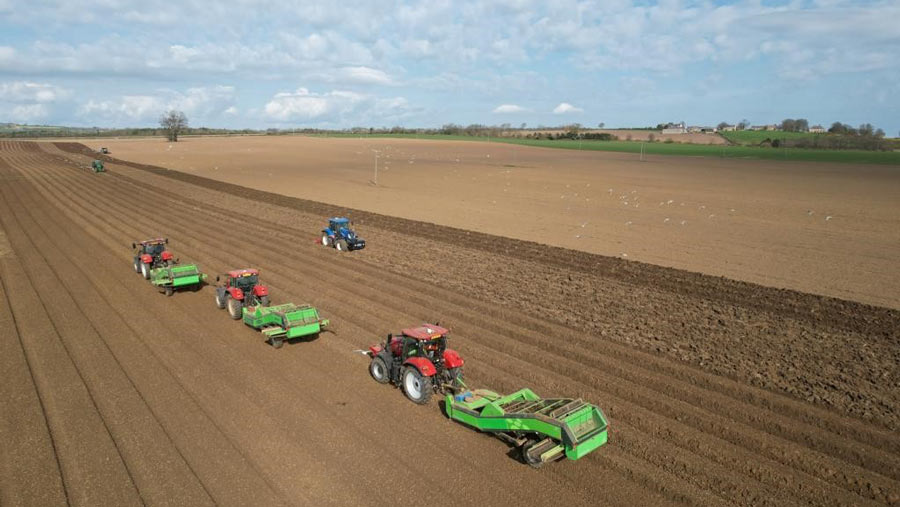Wet weather delays potato planting and risks yield loss
 © Peter Grewar
© Peter Grewar Wet weather has pushed potato planting more than two weeks behind schedule for many growers across the UK. We catch up with two farmers to find out how they are getting on.
See also: Latest-ever start to potato planting for Essex grower
Grewar Farming, Scotland
Yield loss likely due to late planting and cold frosts
Cousins Peter and Euan Grewar, who grow a huge 650ha area of potatoes in northern Scotland, are anticipating a 5-10% yield penalty as the optimum planting window closes.
Planting began on 17 April after persistent wet weather stalled field work, but a wintery blast of freezing temperatures is causing further concern.
Currently, 25% of the 490ha area of ware potatoes is planted – where the cousins would usually expect to be 70% planted for this time of year.
“We are already about two to three weeks behind on spring work, which we won’t be able to get back.
“With later potato planting, we expect fewer tuber numbers and yield penalties between 5-10% – going by our yield records from late-start seasons in 2012, 2016 and 2018,” says Peter.
What’s more, temperatures reached below freezing this week at the farm in north-east Scotland on the Perthshire/Angus border.
“We had a frost on Monday night as low as -2C, which will restrict potato development for crops we have already got in the ground,” he says.
Planting would usually take place in the first week of April when soil temperatures are about 6-10C and rising, but cold temperatures mean growing conditions are certainly below optimum for the time of year.
“A soil temperature below 6C means potatoes will not grow,” notes Peter.
A four-week planting window of good weather is required to get the 490ha ware and salad crop and 160ha seed crop in the ground.
If the weather settles and no more delays are on the cards, the Grewars could be set for a mid-May finish date.
Late harvest risk
When it comes to harvest, Peter aims to be complete by the end of October before the risk of frost becomes too great, which would cause quality and yield loss.
With such a large-scale potato enterprise located so far north in Scotland – stretching from Perthshire and Angus to the Black Isle and Easter Ross, one of his main concerns is too late a harvest date.
“At the start of the harvest season we select crops according to variety and crop size in order to make the most of the market, but once we get to the tail-end of harvest there is a distinct diary date we need to get crops out of the ground before frost risk and winter weather is our main concern.”
He continues that the weather in May, June and July will be all to play for and remains hopeful for a good growing season to make up for the lost time.
“We haven’t got all the spring barley in the ground yet, so once we get drilled up we can focus labour and machine power on the potato side of the business over the next few weeks,” he says.
David Park, Northumberland
Good planting progress after initial weather delays

© David Park
Despite a two-week later start than usual, Northumberland farmer David Park is making good potato planting progress at Buston Barns near Morpeth.
Now the weather has improved, planting is all go, with two bed-formers, three de-stoners and a planter deployed in fields to get the 120ha crop in the ground.
Mr Park says more than 25% of the crop is now planted after six days, so he is hopeful he will be finished up by the May half term.
However, this season sees him scaling back his potato area, due to rising input costs and limited land availability.
“We’ve cut back by about 25ha this season as potato growing land is limited and we don’t plant on marginal land.
“Normally we grow about half our potato area on rented ground but this year it’s about one-third,” he says.

